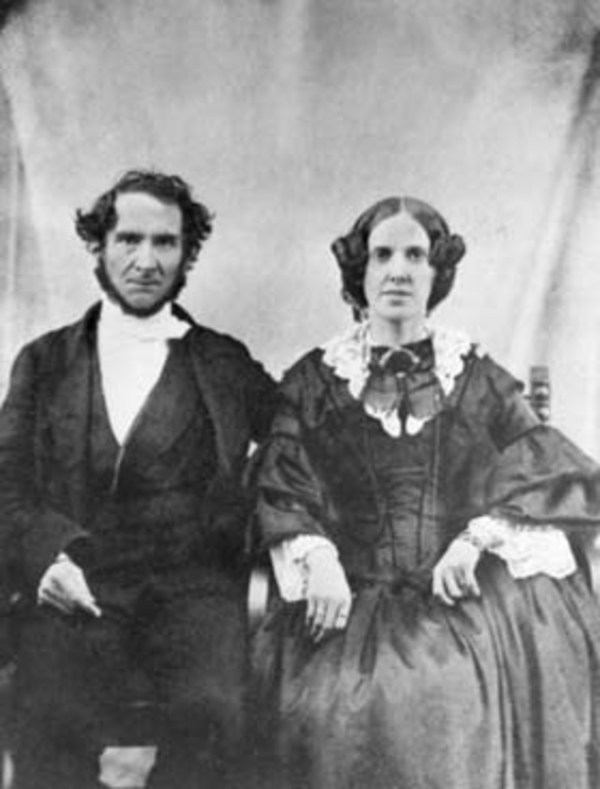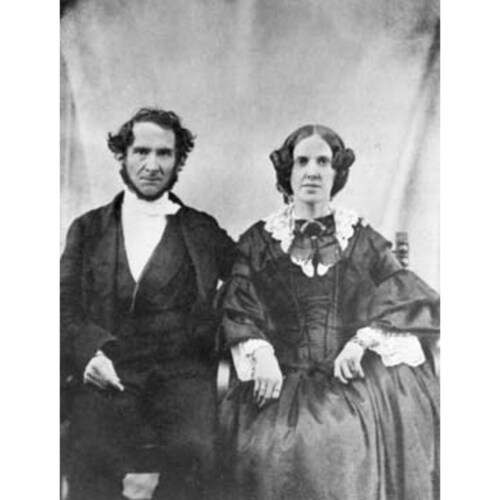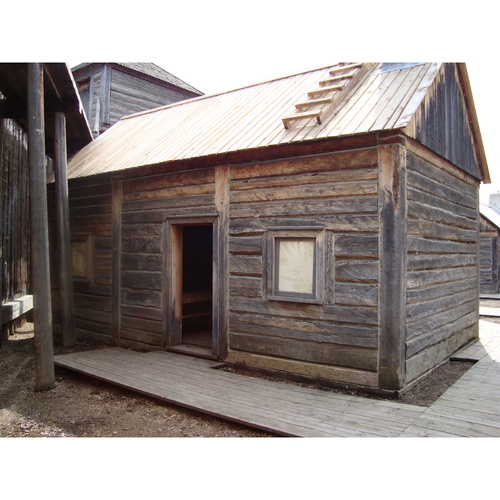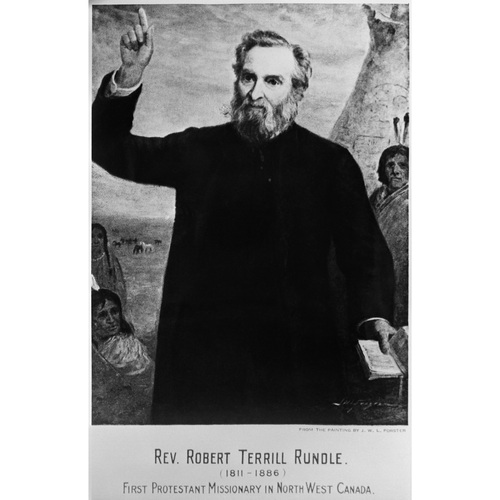
Source: Courtesy of Wikimedia Commons
RUNDLE, ROBERT TERRILL, HBC chaplain, Wesleyan Methodist missionary, and teacher; b. 11 June 1811 in Mylor, England, third son of Robert Rundle and Grace Carvosso; m. September 1854 Mary Wolverson in Coseley, England, and they had nine children; d. 4 Feb. 1896 in Garstang, England.
Influenced by his grandfather William Carvosso, a Methodist lay preacher, and his uncle the Reverend Benjamin Carvosso, Robert Terrill Rundle was already active in the affairs of the Wesleyan Methodist Church when he entered business school at Botreaux Castle, on the west coast of Cornwall, in 1837. Two years later he was called to the ministry and after only two months of training he was offered a posting as missionary for the Hudson’s Bay Company’s Saskatchewan district.
Rundle was one of four Methodists invited by the HBC to establish missions in their territories. George Simpson*, the HBC governor, had become convinced that both the Anglican and the Roman Catholic clergy in Rupert’s Land were beyond company control. He tried to limit their activity to the Red River colony (Man.) and placed the more pliable Methodist missionaries at strategic locations in the interior. Simpson’s friend Robert Alder*, British secretary of the Wesleyan Methodist Missionary Society, who was responsible for British North America, had guaranteed that the Methodists would not interfere with HBC business. Ordained on 8 March 1840, Rundle left for North America eight days later with George Barnley, missionary for Moose Factory (Ont.), and William Mason [see Sophia Thomas*] missionary for Rainy Lake. Arriving at New York, they travelled up the Hudson River to Montreal, and from there on to Norway House (Man.) by canoe, where they were joined in August by the superintendent of the Methodist mission to the HBC territories, James Evans*.
After spending several months at Norway House, Rundle arrived at Fort Edmonton (Edmonton), centre of the Saskatchewan country, on 18 October. He soon established a rigorous itinerary that he would maintain for much of the next seven years. The winter months were usually spent at Fort Edmonton, Lesser Slave Lake post, and Fort Assiniboine; in the spring, summer, and fall he made regular visits south to Rocky Mountain House (Alta), Pigeon Lake, Battle Lake, and Gull Lake, although he occasionally strayed as far as forts Carlton and Pitt (Sask.). He also went into Blackfoot country to Big Hill Springs (near Cochrane, Alta) in 1841 and the Highwood River in 1847. Only in 1844 and 1847 did he go into the Rocky Mountains, first to the area near the mountain that today bears his name and then to Lake Minnewanka.
During the early years of his mission Rundle was usually accompanied in his travels by a guide, or he travelled with HBC officers such as John Edward Harriott* or John Rowand*. As he grew more confident in the Cree language, he and his mixed-blood translator William Rowland travelled alone with Indian friends including Benjamin, son of Maskepetoon*. In the severe cold of the Prairie winter he travelled, as his diary notes, by “dog cariole . . . warmly clad, sealskin cap tied under the chin, mocassins, pair of lambs-wool stockings, flannel shirt, woollen shirt, woollen drawers to foot, thick trousers lined, leggings & black silk gaiters, coat, waistcoat, pilot coat & shawl tied round the neck . . . buffalo robe & two blankets.” In summer he travelled on horseback and only infrequently boarded a canoe or the risky, uncomfortable bateaux used by the fur traders. In 1846, when travelling on horseback in the company of Paul Kane* and Rowand, he also took along his cat.
Rundle appears to have been at ease with the Methodist dictum “Christianity first then civilization,” for he placed the meeting-camp above the establishment of mission stations or his duties as HBC chaplain. The HBC, however, pressed for an Indian mission school and agricultural station near Fort Edmonton. Although Rundle did begin to educate Rowand’s daughters at the fort, he never set up the proposed school. He considered various sites, including Battle Lake, Pigeon Lake, and a Bow River site towards the south, and formally sought both WMMS and HBC support for the school in 1846. In late 1847 Pigeon Lake was selected as the site, but it was Benjamin Sinclair, Rundle’s convert and a catechist from Norway House, who started work there.
Relations between Rundle and his associates were generally good. Such HBC officials as Chief Factor Rowand found him likeable, if somewhat inexperienced and indiscreet, spending too much time gossiping with the young clerks and mixed-bloods. With others, such as John Harriott, who generally arranged the large Indian camp meetings at Rocky Mountain House, he was the best of friends. Firm instructions from Governor Simpson to show Rundle every kindness and the fact that he was unmarried no doubt eased his integration into fur-trade society. He did, however, have some early difficulties with his mixed-blood guides and interpreters. Jimmy Jock [James Bird] barrassed Rundle in the spring of 1841 when, after calling a gathering of Blackfeet for the missionary, he refused to translate. Another interpreter, John Cunningham, deserted him in the field more than once. From November 1841 until the end of his mission, however, Rundle was able to count on the faithful services of William Rowland as translator, and from 1844 Benjamin joined the entourage on a permanent basis.
During his eight-year mission Rundle spent his fondest months in the area around Rocky Mountain House and Gull Lake, where he befriended many mixed-bloods, Cree, and Assiniboins. He had had an initial impact on the mixed-bloods of Lesser Slave Lake and forts Assiniboine and Edmonton in 1841, but because the majority were Métis of French Canadian extraction they were easily swayed from Methodism to Catholicism by Father Jean-Baptiste Thibault* during his visits in 1842.
In July 1847 Rundle seriously injured his arm falling from his horse. The arm did not heal properly and in the autumn of 1848, without awaiting permission from either the WMMS or the HBC, he left for England to seek medical attention. He served on various circuits in England until his retirement in 1887, but he never returned to the northwest.
Robert Terrill Rundle’s journals have been published as The Rundle journals, 1840–1848, intro. G. M. Hutchinson, ed. H. A. Dempsey (Calgary, 1977).
Glenbow Arch., M1080–83. UWOL, Regional Coll., James Evans papers. Paul Kane, Wanderings of an artist among the Indians of North America from Canada to Vancouver’s Island and Oregon through the Hudson’s Bay Company’s territory and back again (London, 1859). Wesleyan-Methodist Magazine (London), 63 (1840)–79 (1856). W. H. Brooks, “Methodism in the Canadian west in the nineteenth century”
Cite This Article
Frits Pannekoek, “RUNDLE, ROBERT TERRILL,” in Dictionary of Canadian Biography, vol. 12, University of Toronto/Université Laval, 2003–, accessed April 4, 2025, https://www.biographi.ca/en/bio/rundle_robert_terrill_12E.html.
The citation above shows the format for footnotes and endnotes according to the Chicago manual of style (16th edition). Information to be used in other citation formats:
| Permalink: | https://www.biographi.ca/en/bio/rundle_robert_terrill_12E.html |
| Author of Article: | Frits Pannekoek |
| Title of Article: | RUNDLE, ROBERT TERRILL |
| Publication Name: | Dictionary of Canadian Biography, vol. 12 |
| Publisher: | University of Toronto/Université Laval |
| Year of revision: | 1990 |
| Access Date: | April 4, 2025 |





